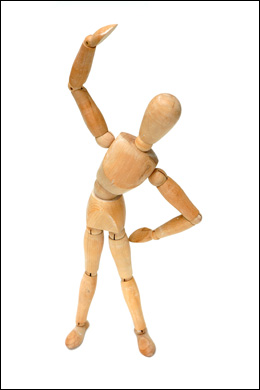The Exercise Trio
Any decent fitness program consists of a combination of stretching, as well as aerobic and anaerobic exercises. Remove one leg from this tripod and the whole program falls. Stretching elongates the muscles, ligaments, and tendons in a way that permits the other two elements of the program to provide maximum benefit. The term aerobic refers to the utilization of oxygen by the muscle to produce the energy necessary for its contraction during mild to moderate physical activity. On the other hand, strenuous, vigorous exercises such as weight training can't be accomplished using oxygen alone, and the muscles employ other chemical means to produce the required amount of energy: an anaerobic system. Unfortunately this anaerobic pathway runs out of steam quickly, and can't be sustained for extended periods of time. That's why slow paced exercises like walking can be done continuously but weight lifting can't, since it requires quick bursts of extra energy. Walking and Weight Bearing As one of the most common forms of aerobic training, walking can be a fun proposition when the weather is nice, and it is certainly excellent for the cardio respiratory system and for the health of the joints. When properly done, it is a first-rate form of posture training, but when utilized alone, walking is a poor exercise option for osteoporosis prevention. Unless additional tension is applied to the skeleton, the bones are unlikely to benefit much from a plain walking program, and they may fail to incorporate a substantial amount of calcium to their structure. A good trick to enhance your workout consists in carrying a few extra pounds while walking, either by holding hand weights, or, better yet, by carrying a backpack. One can add weight to the backpack in the form of plastic water bottles, which can be emptied at any time if they become too heavy. As an alternative, water-carrying backpacks, such as the ones utilized by bikers and hikers, may provide not only the weight to power your stroll, but will also supply hydrating fluids during long walks. This weight carrying method loads the spine and the long bones of the body, like the femur, with the added tension and stress necessary for bone strengthening. In order to avoid the low back pain that can arise from carrying too much weight over one's shoulders, some people may be better served by utilizing a weighted belt around the waist, therefore sparing excessive stress over the low back, and though it loads the bones in the lower extremities, it won't help prevent osteoporosis of the spine. Aquatic Exercises Water therapy is an excellent exercise modality but it should be regarded as only one part of a more comprehensive posture program, because it does not challenge the skeletal system with enough weight or resistance. Nevertheless, everyone except the very frail can do an aerobic water workout, since it carries little chance of injuries. For those who prefer to swim, it is indeed one of the best aerobic exercises one can do, and it helps develop the trunk muscles responsible for proper posture. People with neck problems may prefer to wear a mask and snorkel while swimming, in order to avoid rotating or overextending the cervical spine when surfacing to breathe. |
Fitness & HealthGoing to the Gym Versus Home Exercises Agonist and Antagonist Muscles Risk factors in Osteoporosis #1 Risk factors in Osteoporosis #2 |